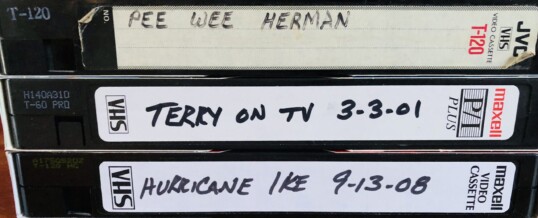
The first time I saw a VCR was in 1979. A buddy of mine got it from a friend who bought things he couldn’t afford.
Many of my most prized acquisitions came through similar channels – people who overbought and then sold to me at a great discount – but that’s for another column.
There was something magical about being able to record something right off of the TV antenna and watch it again. And again, if you wanted. But at first, a VCR wasn’t generally viewed as something everyone would have in their home.
At the time, VCRs were a novelty. The only people who could afford them were rich folks, and people who had buddies who bought things they couldn’t afford and then sold to them at a great discount.
With the price tag of two used Buicks, and the weight of three, VCRs were interesting. They were somewhat reminiscent of 8mm home movie cameras and projectors, but VCRs had sound. And you didn’t have to send the film off to be developed and wait for it to come back.
VCR technology had been around for a bit in the TV industry. As far as something that could be used in the home, videotape was a huge step toward what we enjoy today: whatever we want to watch, whenever we want to watch it.
But in the late 70s and early 80s, this was pretty groundbreaking stuff. Anyone with a VCR could be assured that they’d have a living room full of friends and relatives on the weekends, just like folks 10 years earlier did who had a color TV when Bonanza and The Wonderful World of Disney came on.
I knew about the latter when my dad bought an RCA color console TV from a relative who had bigger aspirations than paychecks. Again, I digress.
The earliest shows I saw played from a VCR were taped episodes of M*A*S*H and other CBS programs. CBS was the reliable network where my friend lived. ABC and NBC came in most of the time, but for some reason CBS was pretty solid.
And that’s how it went in the beginning. People taped TV shows, which allowed them to live life without having to miss their favorite programs. It became an even bigger deal for people who lived in town and later got cable TV. Then they could tape movies from HBO. This allowed people to start building private movie collections.
Today, we don’t think twice about watching things on demand, but not so long ago you watched whatever the three networks fed you and you either liked it or did something other than watch television.
But VCRs changed that. And for a while, there were two VCR formats: VHS and Beta. A number of companies were invested in the VHS format, which had a slightly larger cartridge and different technology for putting the images and audio to tape. Honestly though, Beta was the better format. The quality of the video and audio was far superior, but marketing is what provided VHS the win.
Just a few years after my friend showed off his VCR, I decided to surprise my parents with a VCR and a store-bought movie. This was before I got married and had kids, so I had the budget to splurge that Christmas. My dad loved Indiana Jones, so I got him Raiders of the Lost Ark. He watched it over and over. It’s one of my favorite memories.
A couple of years later, VCRs were fairly common. Stores such as Sears and JC Penney offered payment plans on credit cards, so it was easier to buy not only a VCR, but a video camera as well. And that’s exactly what I did when my oldest started playing soccer.
I really don’t know what we thought we’d do with hours of footage of five-year-olds trying to play soccer, but we certainly captured every exciting moment of it.
We also caught footage of children’s church performances, school plays, family reunions, and in my case, interviews of my family members.
In the mid-80s, I sat my surviving grandparents down and interviewed them. They told their life stories, which I later pulled out and compiled into documentary format for my grandmother when she passed. She shared her own history at her own service. She was even able to witness to those in the audience.
But VHS was eventually replaced by DVDs just as CDs had supplanted 8-tracks and cassettes. Our desire to experience things repeatedly hasn’t waned, but how we experience them has.
Today, you’ll see VHS tapes that once sold for over $100 (think Raiders of the Lost Ark in 1982) sitting in a resale shop with a bundle price if you buy more than one tape.
If you still have tapes of family reunions, and other treasures sitting in the attic, you should consider having a professional service transfer those to digital. Because unlike vinyl records, which last just about forever (and have made a comeback), VHS tapes eventually disintegrate and won’t last.
So if you want to rewind to the past, dig out those old VHS tapes and take a look at how life used to be. Back when we had very few TV channels, but a lot of soccer games.
©2023 John Moore
John’s books, Puns for Groan People and Write of Passage: A Southerner’s View of Then and Now Vol. 1 and Vol. 2, are available on his website – TheCountryWriter.com, where you can also send him a message and hear his weekly podcast.
DEC
2022
